The Cornell Lab Bird Academy › Discussion Groups › Nature Journaling and Field Sketching › Noticing Themes in Nature
-
Bird AcademyBird AcademyAre you starting to recognize some of the “themes” in the natural world more readily? Can you share some examples? Upload one of your journal pages reflecting one of the themes, if you’d like to. There are no right or wrong answers!You must be enrolled in the course to reply to this topic.
-

-

-

-

-
 Observation: It is a brisk windy cold day. Our feeders have about fifty or more goldfinches competing for food today. Several pairs of Bluebirds flit in and out. Multiple Juncos and an occasional mockingbird visit. But, at the moment it is goldfinch land. The difference between the male and female is becoming more pronounced due to nesting season approaching.
Possible Explanation: Ample food is bringing them together as they consume the niger and sunflower seeds. There are competitions and then there is pairing off occasionally and one goldfinch will give a mealworm to another. Nesting season is around the corner so the pairing should begin in earnest soon.
Questions: Can I keep the goldfinch around? Which food does the goldfinch like better? Which trees are better for their nests? I would love to see a nest weaved with spider webs. I have coneflowers everywhere to hopefully keep them around. At the moment shoots of the coneflowers are just peaking out of the dirt. Can't wait for spring.
Observation: It is a brisk windy cold day. Our feeders have about fifty or more goldfinches competing for food today. Several pairs of Bluebirds flit in and out. Multiple Juncos and an occasional mockingbird visit. But, at the moment it is goldfinch land. The difference between the male and female is becoming more pronounced due to nesting season approaching.
Possible Explanation: Ample food is bringing them together as they consume the niger and sunflower seeds. There are competitions and then there is pairing off occasionally and one goldfinch will give a mealworm to another. Nesting season is around the corner so the pairing should begin in earnest soon.
Questions: Can I keep the goldfinch around? Which food does the goldfinch like better? Which trees are better for their nests? I would love to see a nest weaved with spider webs. I have coneflowers everywhere to hopefully keep them around. At the moment shoots of the coneflowers are just peaking out of the dirt. Can't wait for spring. -
I have often wondered how cowbirds can find their own mates, when they are raised from the egg to the sounds, songs and patterns of other birds. I know a little about imprinting, but I don't know how cowbirds can recognize other cowbirds unless they are genetically "hard wired" to recognize their own kind. If that's the case, how do tnhey do this?
-

 I'm definitely struggling with creating depth in the landscapes. Hopefully, that lesson will come soon:) I also realize I don't have a lot of patience for drawing lots of details. There are so many trees that made sketching very complex for my basic skills.
I'm definitely struggling with creating depth in the landscapes. Hopefully, that lesson will come soon:) I also realize I don't have a lot of patience for drawing lots of details. There are so many trees that made sketching very complex for my basic skills. -
Learning to simplify a scene is a really necessary skill when drawing landscapes. Maybe you don't need to draw every tree, but a representative set of them. Sometimes picking a smaller field of view will help too. Our eyes see such a wide format, but the drawing needs to be smaller in scope.
-
@Suzanne I've been meaning to thank you for this advice. It will be helpful as I get out and attempt to capture more landscapes. The weather has been awful each weekend when I try to get outside. Hopefully, it will change soon. It still feels like February in Massachusetts.
-
-

-
January 18, 2024 Observation: Watching back yard through inside back room, with window open. Cloudy day after a rainy day previously, with some sun peeking through the clouds. Hearing "crackle" sounds through the open back window (persistent sound for 1/2 hour). Possible explanation: Rain from the tree branches has collected in places, gradually falling like rain in "drips", but causing the branches to sound like "crackle"? Actually pieces from the trees are falling (small branches, leaves, etc.) after weight from the collected water causes them to fall? Weight of the water collected makes the tree bark expand and makes a sound? Questions: Do only certain trees respond this way after a rain? (we have many kinds of trees here in the yard) Does it take an animal (like a squirrel, of which there are many, or birds) running through the trees or lighting on them to make the sounds happen? Does the sun have any affect on this process to cause the water-soaked branches to expand or ??
-
I have noticed the consistent return of a rabbit at around the same time. He hops cautiously out of the invasive cesarweed and munches on the grass. Through further investigation of my question,'why does this rabbit come out at the same time every day?' I have made thehypothosis that predators (mostly hawks) are not out during the period of time. Now I am stuck in the loop of natural curiosity!
-

-
I have been trying to get better at noticing change, which I attempted by doing a study of an Oak tree that was being defoliated by Spongy Moth caterpillars. I would like to work on counting and measuring more as well, putting more numbers into my journaling.

-
 While sitting for a long time in a grassy park meadow, I realized, almost suddenly, just how many dragonflies were zipping around through the air. I wondered what they were doing. It was golden hour, not quite dusk, and I know many animals are most active during sunrise and dusk. I guessed they might be feeding, and wondered what dragonflies eat. Maybe the little gnats and flies I had observed in the still air around the park? I wondered how they eat...like are they able to just eat a bug and keep zipping around?
I looked it up to see, and my guesses seem plausible: dragonflies eat other flying insects, such as flies, midges, and mosquitos. They can also even eat butterflies and larger dragonflies. Google says that although they can catch prey in mid-air using their legs (weird), they carry their food to a perch to eat it.
While sitting for a long time in a grassy park meadow, I realized, almost suddenly, just how many dragonflies were zipping around through the air. I wondered what they were doing. It was golden hour, not quite dusk, and I know many animals are most active during sunrise and dusk. I guessed they might be feeding, and wondered what dragonflies eat. Maybe the little gnats and flies I had observed in the still air around the park? I wondered how they eat...like are they able to just eat a bug and keep zipping around?
I looked it up to see, and my guesses seem plausible: dragonflies eat other flying insects, such as flies, midges, and mosquitos. They can also even eat butterflies and larger dragonflies. Google says that although they can catch prey in mid-air using their legs (weird), they carry their food to a perch to eat it. -
I was wondering about the Chickadee's Black caps, for which they are named. Are they a form of camouflage? Are they to attract a mate? Black cap males tend to have larger bibs and caps then females, so perhaps this is the case. The two generations of chickadees are shown here; Gen C: the younger, tan chickadee, and Gen A, the older, green chickadee. I wonder why the juveniles are browner then the adults? Also, a male Indigo Bunting sits at the top of a specific tree at least once a day. This certainly seems to indicate his established territory. Oddly enough, it includes the feeder, which many other species of bird come to, including egg-stealing jays. Why doesn't the Bunting chase them off? Perhaps the feeder is no-birds-land for them.

-
Since beginning to bird, I've been going back to same park at least once a month. I can see how the type and number of birds change as the seasons progress.
-
April 10, 2023, northeastern Connecticut. Observations: While I was out on my first "sit spot" excursion, I found two bird species that shared an unusual behavior, and a third species that did something similar, but not exactly the same. I only saw about six species of birds, and for three of them to catch my eye in this way was, well, eye-catching. The Louisiana Waterthrush and the Palm Warbler have just returned from winter in the neotropics, and the Eastern Phoebe has been back for a couple of weeks already. The Waterthrush and this particular warbler are both tail-bobbers and the phoebe is a tail-wagger. The phoebe sits very upright (flicking its tail) and hunts for flying insects from perches in trees. The other two species hold their bodies in a rather horizontal posture and bob their entire back end up and down - they forage either on the ground or from low branches, where they are hunting for various invertebrates. Possible explanations: Does it have to do with the hunting behavior? does it scare up insects? does it give the bird a different perspective by changing the angle at which it views the ground for potential prey? And while we're at it - it's a whole different mechanical action! the phoebe must be using just a few muscles that activate the tail and the waterthrush and warbler use the hip and leg joints, which I suppose would require a little more energy. Further questions: I'm hoping some ornithology graduate student somewhere has taken slow-motion video and analyzed the body motion and the gaze of the bird and the activity of insects around the bird - and already answered my question. But what's weird, is that I saw them all in one outing, and this behavior is not widespread among little songbirds. So, further questions, which other birds do this? and what does the research show?
-
As a frequent "forest bather" (we are fortunate to live at the base of a mountain that is protected and open for wanderings) I have wondered about a lot of the themes you have mentioned here without realizing that's what I was doing. For instance, every spring beavers show up on our creek and take down a few small trees. We have wondered where they're lodging. If they were damming up this creek we would see massive flooding. So how far are they traveling to harvest these trees? And then again since we've never actually seen them could it be a different animal? I don't know of any other that cuts saplings down quite like this. We have pink lady slippers growing on this mountain. Some years they appear. Others they don't. I've wondered why. Is something eating the bulbs/root systems? Do the conditions required for their thriving change? I know they prefer soil around fallen pine trees but now what else can I observe about them? ' Just two of my wonderings. I appreciate this explanation of themes in the natural world. I have noted them in my journal and intend to revisit them with each trip I make into the wild and wonderful world we live in.
-
 I
I -
Your goldfinch is awesome!
-
@Donita Yup. This is amazing!
-
-

 Me and my sister looked at birds in are yard and we noticed a few forms and functions and noticed some changes.
Me and my sister looked at birds in are yard and we noticed a few forms and functions and noticed some changes.
-
This particular concept of Noticing the themes, I personally prefer is a continuous process of our observations. I think while observing any particular species or nature in general. Especially when we do bird watching, most of these themes are observed, explained, and questioned. But the only thing is when we put it in Journal, we need to really add all these in detail. Thanks which I am learning now to add to my journal. Scale and Quantity, forms, and functions are very essential themes that most of us observe, and for me, the new learning about noticing the change, especially the beaver dam was eye-opening. Your Mushroom example for the ecosystems was always surprising or magical in my childhood which I never gave so much thought to at that age. Now after starting this nature journal it's taking me back to those scientific explanations and the need to understand their importance. Currently, i do not have an image for this, will try to work on all five themes and upload it.
-
 I found myself journaling at 4:18 pm. The sun had not set but it was dusk and a half moon sat in the sky. American robins were noisily chatting to each other with an occasional alarm (?) call. There were 2 Anna's hummingbirds flying between a bare large leaf maple and a Douglas fir. A northern flicker gave a few shrill calls and fell silent for the duration. American crows could be heard in the distance but were not present where I sat. I was surprised to find I have been misidentifying the fox sparrow as a song sparrow - according to MerlinID. Since this is winter, the birds were using calls not songs so I needed the help of Merlin to identify the birds I could not see. The robins were very active flying tree to tree and calling to each other. The sparrows were concealed in a Laurel hedge. Interesting to find the robins in the trees. In the early morning I see them in large flocks in the short grass. The robins sat in the trees with their wings hung low as pictured. It was a common trait I found with most of the robins sitting in the trees.
I found myself journaling at 4:18 pm. The sun had not set but it was dusk and a half moon sat in the sky. American robins were noisily chatting to each other with an occasional alarm (?) call. There were 2 Anna's hummingbirds flying between a bare large leaf maple and a Douglas fir. A northern flicker gave a few shrill calls and fell silent for the duration. American crows could be heard in the distance but were not present where I sat. I was surprised to find I have been misidentifying the fox sparrow as a song sparrow - according to MerlinID. Since this is winter, the birds were using calls not songs so I needed the help of Merlin to identify the birds I could not see. The robins were very active flying tree to tree and calling to each other. The sparrows were concealed in a Laurel hedge. Interesting to find the robins in the trees. In the early morning I see them in large flocks in the short grass. The robins sat in the trees with their wings hung low as pictured. It was a common trait I found with most of the robins sitting in the trees. -

-
I don't have a journal page really reflecting this yet, but I notice I tend to focus on scale/quantity-- especially quantity. Numbers that I can count. Hard data. One thing I'd like to use this nature journaling for is to allow myself to begin exploring other themes. I'm really interested in observing energy flow and change in the natural areas of the farm I live on.
-
 I noticed that the scaups I saw yesterday and the Ring Necked ducks today are hard to distinguish from each other. They have very similar coloring of white and dark.
The large white bellies and white patches on its body (male) make it blend into the reflection of the water.
The black helps blend as shadows.
Scaups and Ring Neck ducks are closely related and occupy the same niche.
Will Scaups and Ring Neck ducks occupy the same area?
Can there only be one type of diving and one type of non-diving duck in a certain sized area?
Do these ducks hybridize? Scaups and Ring Neck?
I noticed that the scaups I saw yesterday and the Ring Necked ducks today are hard to distinguish from each other. They have very similar coloring of white and dark.
The large white bellies and white patches on its body (male) make it blend into the reflection of the water.
The black helps blend as shadows.
Scaups and Ring Neck ducks are closely related and occupy the same niche.
Will Scaups and Ring Neck ducks occupy the same area?
Can there only be one type of diving and one type of non-diving duck in a certain sized area?
Do these ducks hybridize? Scaups and Ring Neck?
Read More:
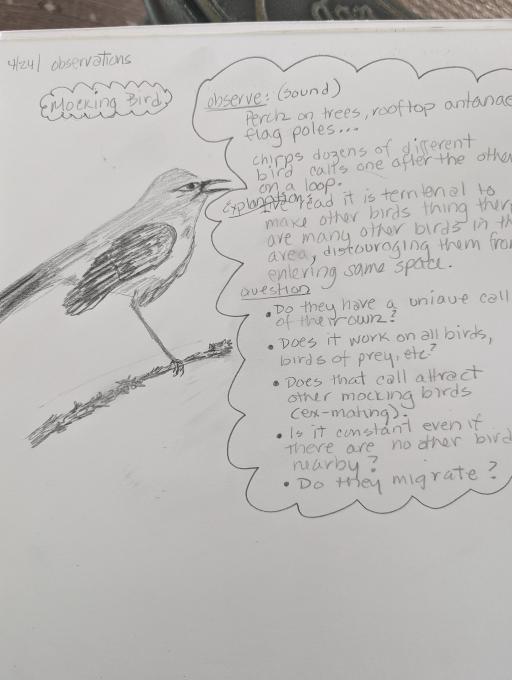


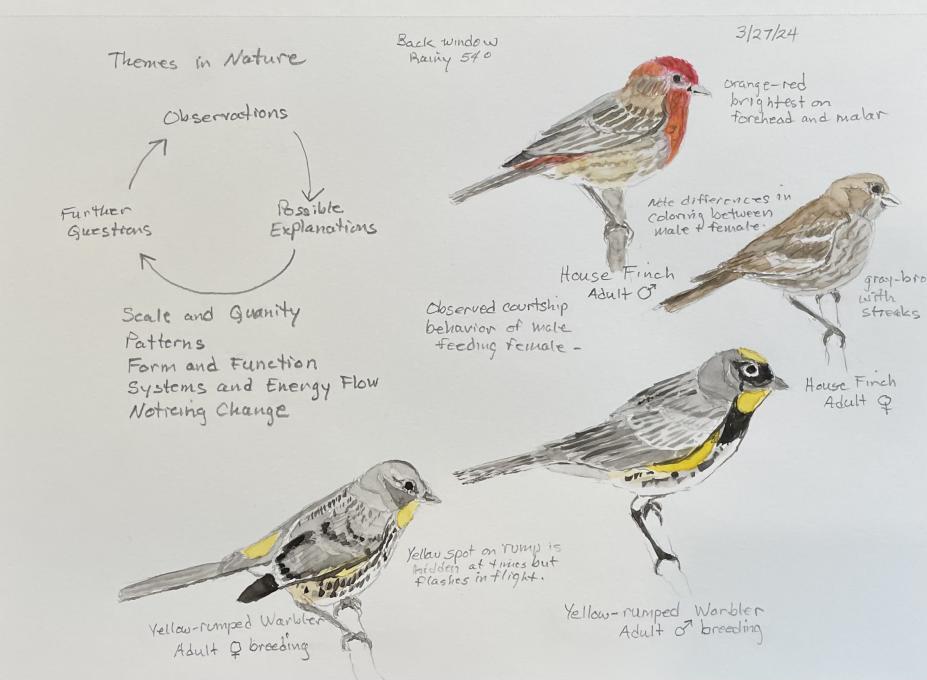
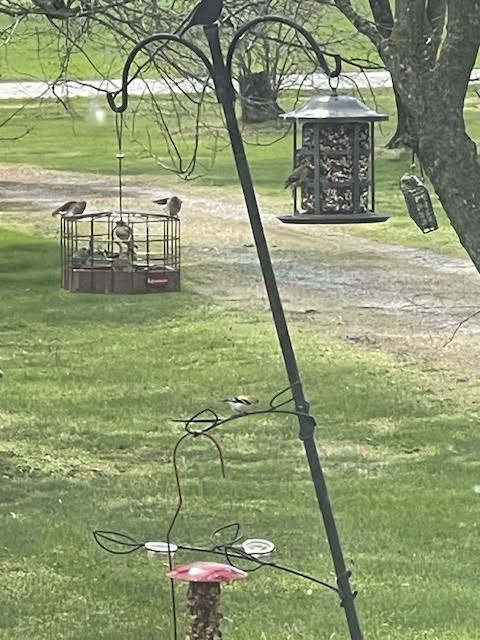 Observation: It is a brisk windy cold day. Our feeders have about fifty or more goldfinches competing for food today. Several pairs of Bluebirds flit in and out. Multiple Juncos and an occasional mockingbird visit. But, at the moment it is goldfinch land. The difference between the male and female is becoming more pronounced due to nesting season approaching.
Possible Explanation: Ample food is bringing them together as they consume the niger and sunflower seeds. There are competitions and then there is pairing off occasionally and one goldfinch will give a mealworm to another. Nesting season is around the corner so the pairing should begin in earnest soon.
Questions: Can I keep the goldfinch around? Which food does the goldfinch like better? Which trees are better for their nests? I would love to see a nest weaved with spider webs. I have coneflowers everywhere to hopefully keep them around. At the moment shoots of the coneflowers are just peaking out of the dirt. Can't wait for spring.
Observation: It is a brisk windy cold day. Our feeders have about fifty or more goldfinches competing for food today. Several pairs of Bluebirds flit in and out. Multiple Juncos and an occasional mockingbird visit. But, at the moment it is goldfinch land. The difference between the male and female is becoming more pronounced due to nesting season approaching.
Possible Explanation: Ample food is bringing them together as they consume the niger and sunflower seeds. There are competitions and then there is pairing off occasionally and one goldfinch will give a mealworm to another. Nesting season is around the corner so the pairing should begin in earnest soon.
Questions: Can I keep the goldfinch around? Which food does the goldfinch like better? Which trees are better for their nests? I would love to see a nest weaved with spider webs. I have coneflowers everywhere to hopefully keep them around. At the moment shoots of the coneflowers are just peaking out of the dirt. Can't wait for spring. 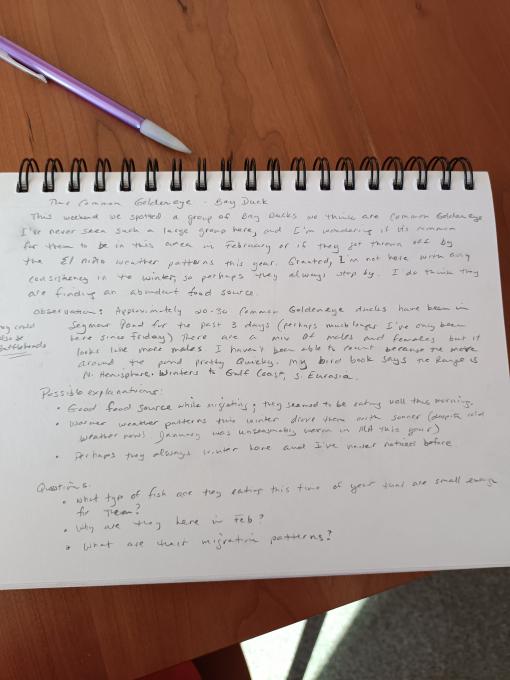
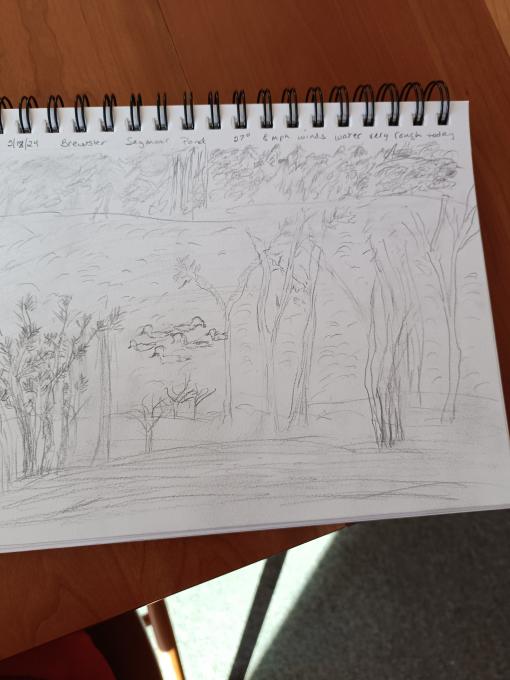 I'm definitely struggling with creating depth in the landscapes. Hopefully, that lesson will come soon:) I also realize I don't have a lot of patience for drawing lots of details. There are so many trees that made sketching very complex for my basic skills.
I'm definitely struggling with creating depth in the landscapes. Hopefully, that lesson will come soon:) I also realize I don't have a lot of patience for drawing lots of details. There are so many trees that made sketching very complex for my basic skills. 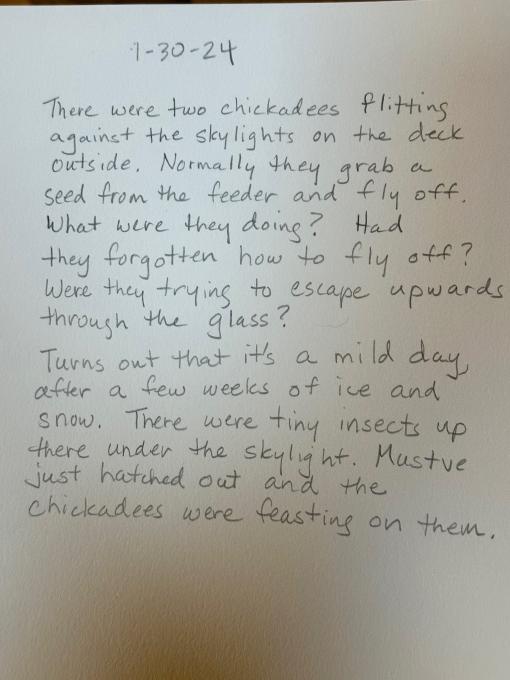


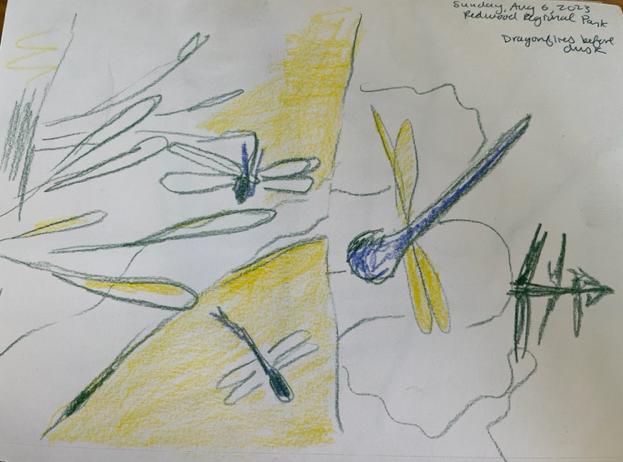 While sitting for a long time in a grassy park meadow, I realized, almost suddenly, just how many dragonflies were zipping around through the air. I wondered what they were doing. It was golden hour, not quite dusk, and I know many animals are most active during sunrise and dusk. I guessed they might be feeding, and wondered what dragonflies eat. Maybe the little gnats and flies I had observed in the still air around the park? I wondered how they eat...like are they able to just eat a bug and keep zipping around?
I looked it up to see, and my guesses seem plausible: dragonflies eat other flying insects, such as flies, midges, and mosquitos. They can also even eat butterflies and larger dragonflies. Google says that although they can catch prey in mid-air using their legs (weird), they carry their food to a perch to eat it.
While sitting for a long time in a grassy park meadow, I realized, almost suddenly, just how many dragonflies were zipping around through the air. I wondered what they were doing. It was golden hour, not quite dusk, and I know many animals are most active during sunrise and dusk. I guessed they might be feeding, and wondered what dragonflies eat. Maybe the little gnats and flies I had observed in the still air around the park? I wondered how they eat...like are they able to just eat a bug and keep zipping around?
I looked it up to see, and my guesses seem plausible: dragonflies eat other flying insects, such as flies, midges, and mosquitos. They can also even eat butterflies and larger dragonflies. Google says that although they can catch prey in mid-air using their legs (weird), they carry their food to a perch to eat it. 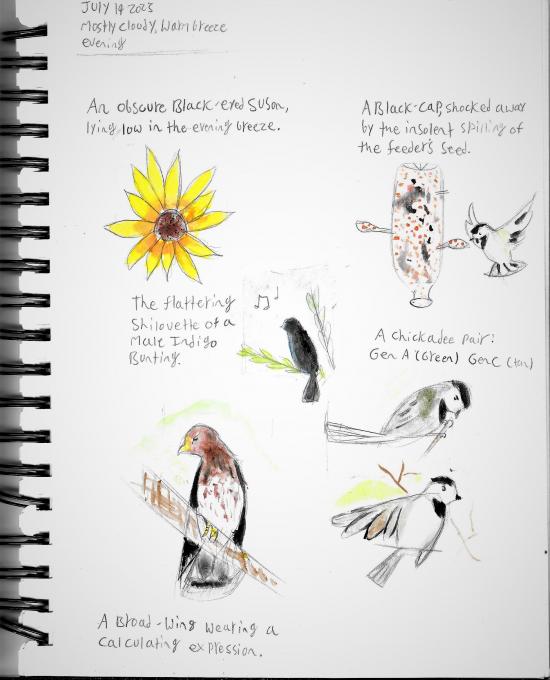
 I
I 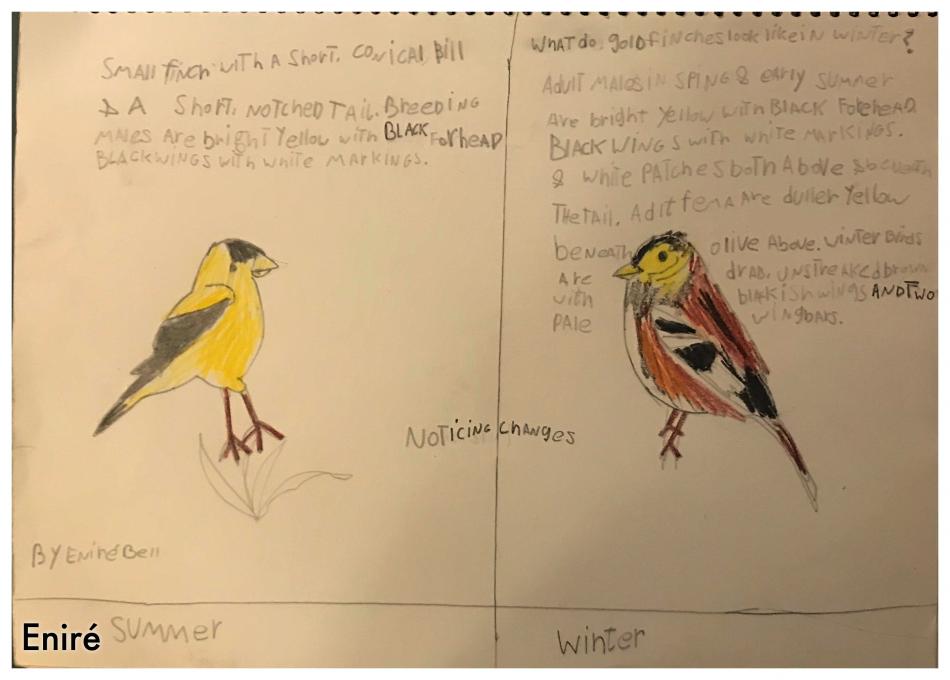
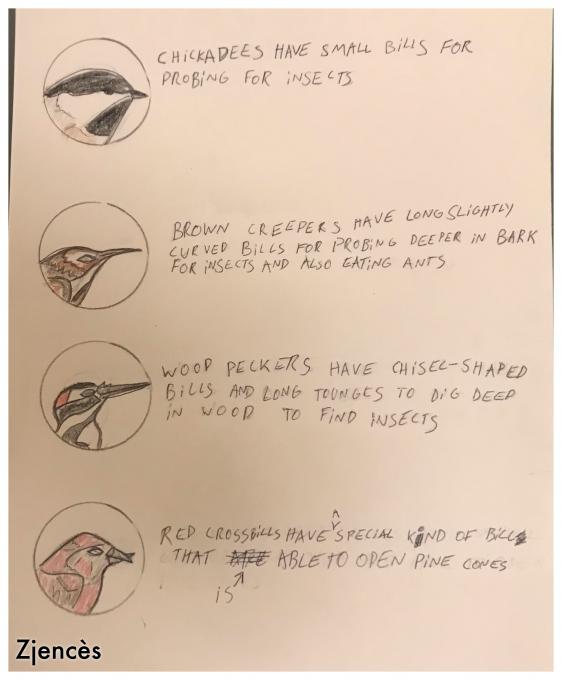 Me and my sister looked at birds in are yard and we noticed a few forms and functions and noticed some changes.
Me and my sister looked at birds in are yard and we noticed a few forms and functions and noticed some changes.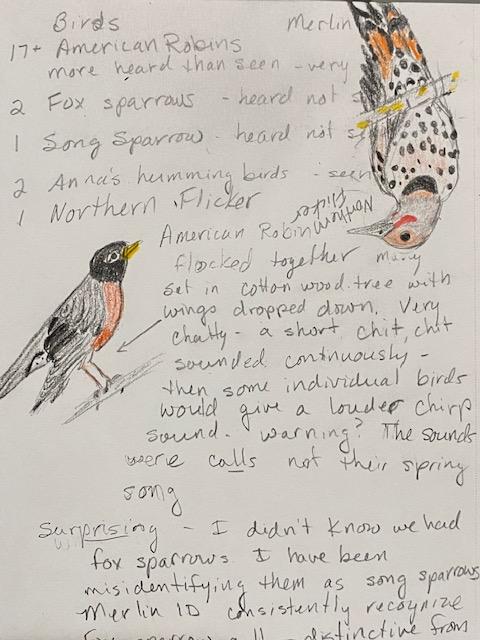 I found myself journaling at 4:18 pm. The sun had not set but it was dusk and a half moon sat in the sky. American robins were noisily chatting to each other with an occasional alarm (?) call. There were 2 Anna's hummingbirds flying between a bare large leaf maple and a Douglas fir. A northern flicker gave a few shrill calls and fell silent for the duration. American crows could be heard in the distance but were not present where I sat. I was surprised to find I have been misidentifying the fox sparrow as a song sparrow - according to MerlinID. Since this is winter, the birds were using calls not songs so I needed the help of Merlin to identify the birds I could not see. The robins were very active flying tree to tree and calling to each other. The sparrows were concealed in a Laurel hedge. Interesting to find the robins in the trees. In the early morning I see them in large flocks in the short grass. The robins sat in the trees with their wings hung low as pictured. It was a common trait I found with most of the robins sitting in the trees.
I found myself journaling at 4:18 pm. The sun had not set but it was dusk and a half moon sat in the sky. American robins were noisily chatting to each other with an occasional alarm (?) call. There were 2 Anna's hummingbirds flying between a bare large leaf maple and a Douglas fir. A northern flicker gave a few shrill calls and fell silent for the duration. American crows could be heard in the distance but were not present where I sat. I was surprised to find I have been misidentifying the fox sparrow as a song sparrow - according to MerlinID. Since this is winter, the birds were using calls not songs so I needed the help of Merlin to identify the birds I could not see. The robins were very active flying tree to tree and calling to each other. The sparrows were concealed in a Laurel hedge. Interesting to find the robins in the trees. In the early morning I see them in large flocks in the short grass. The robins sat in the trees with their wings hung low as pictured. It was a common trait I found with most of the robins sitting in the trees. 
 I noticed that the scaups I saw yesterday and the Ring Necked ducks today are hard to distinguish from each other. They have very similar coloring of white and dark.
The large white bellies and white patches on its body (male) make it blend into the reflection of the water.
The black helps blend as shadows.
Scaups and Ring Neck ducks are closely related and occupy the same niche.
Will Scaups and Ring Neck ducks occupy the same area?
Can there only be one type of diving and one type of non-diving duck in a certain sized area?
Do these ducks hybridize? Scaups and Ring Neck?
I noticed that the scaups I saw yesterday and the Ring Necked ducks today are hard to distinguish from each other. They have very similar coloring of white and dark.
The large white bellies and white patches on its body (male) make it blend into the reflection of the water.
The black helps blend as shadows.
Scaups and Ring Neck ducks are closely related and occupy the same niche.
Will Scaups and Ring Neck ducks occupy the same area?
Can there only be one type of diving and one type of non-diving duck in a certain sized area?
Do these ducks hybridize? Scaups and Ring Neck?